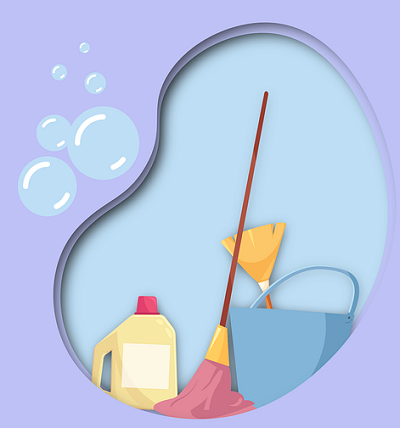A clean and healthy home is essential for the well-being of you and your family. Not only does a clean home look appealing, but it also minimizes health risks caused by dust, mold, bacteria, and other contaminants. Here is a comprehensive guide to the most effective cleaning techniques, tips, and methods for maintaining a healthier home.
1. Start with a Cleaning Schedule
Establishing a regular cleaning routine is the first step to maintaining a healthier home. A well-structured cleaning schedule helps to manage tasks effectively, ensuring that each area of your home receives attention. Here are a few tips to create an efficient schedule:
- Daily Tasks: Focus on tasks that prevent the build-up of dirt and clutter. This includes making the bed, wiping down kitchen counters, washing dishes, and sweeping floors.
- Weekly Tasks: Set aside time each week for deep cleaning tasks like vacuuming carpets, mopping floors, dusting furniture, and cleaning bathrooms.
- Monthly Tasks: Clean areas that do not require frequent attention, such as washing windows, wiping down baseboards, and deep-cleaning appliances.
- Seasonal Tasks: Declutter closets, clean gutters, shampoo carpets, and rotate mattresses.
2. Effective Dusting Techniques
Dust contains allergens, pet dander, and other pollutants that can trigger respiratory issues and allergies. Here’s how to tackle dust effectively:
- Use a Microfiber Cloth: Microfiber cloths trap dust rather than spreading it around. They’re more effective than regular dusters or cotton cloths.
- Dust High to Low: Always start dusting from the top surfaces, such as shelves and high furniture, and work your way down to avoid settling dust on cleaned surfaces.
- Don’t Forget Hidden Spots: Dust areas like window sills, ceiling fans, light fixtures, vents, and the tops of door frames. Use an extendable duster for hard-to-reach places.
- Regularly Clean Upholstery: Use a vacuum cleaner with an upholstery attachment to clean couches, cushions, and curtains.
3. Sanitize High-Touch Surfaces
High-touch surfaces, such as doorknobs, light switches, remote controls, and faucets, are breeding grounds for germs and bacteria. Regular sanitization can prevent the spread of illnesses:
- Choose Effective Disinfectants: Use EPA-registered disinfectants or make a homemade solution using a mix of water and rubbing alcohol (at least 70% concentration).
- Proper Technique: Wipe the surface first with a damp cloth to remove dirt, then apply the disinfectant and allow it to air dry for maximum effectiveness.
- Frequent Cleaning: Sanitize these high-touch areas daily, especially during flu seasons or if someone in the household is ill.
4. Deep Cleaning the Kitchen
The kitchen is often the heart of the home but can also harbor bacteria from food spills, grease, and grime. Follow these steps to keep it spotless:
- Clean Countertops: Wipe countertops daily using a multipurpose cleaner. For granite or marble surfaces, use a gentle, pH-neutral cleaner to avoid damage.
- Disinfect Cutting Boards: Use hot, soapy water to wash cutting boards after every use. For deeper cleaning, rub them with half a lemon sprinkled with salt.
- Clean Appliances:
- Microwave: Heat a cup of water with lemon slices for a few minutes, then wipe away grime with a cloth.
- Oven: Use baking soda and water paste to remove stubborn stains. Let it sit overnight and wipe it clean in the morning.
- Refrigerator: Empty the fridge every few weeks, wipe down shelves with soapy water, and discard expired food items.
- Sweep and Mop Floors: Sweep daily to remove crumbs and mop weekly with a mixture of warm water and mild detergent.
5. Bathroom Cleaning for Maximum Hygiene
Bathrooms are prone to mold, mildew, and bacteria build-up, making regular and thorough cleaning essential:
- Shower and Tub: Use a mixture of white vinegar and water to clean soap scum from shower doors and tubs. For tougher stains, use a baking soda paste.
- Toilet Cleaning: Apply toilet bowl cleaner under the rim and allow it to sit for a few minutes before scrubbing with a toilet brush. Clean the outside surfaces with a disinfectant.
- Grout and Tiles: Scrub grout lines using a mixture of baking soda and water with an old toothbrush. Rinse tiles with water and a soft cloth.
- Ventilation: Always use the bathroom fan to reduce moisture, preventing mold and mildew growth.
6. Bedroom Cleaning and Organization
A clean bedroom promotes better sleep and reduces allergens:
- Change Bedding Weekly: Wash sheets, pillowcases, and blankets in hot water to kill dust mites and bacteria.
- Vacuum Regularly: Use a vacuum with a HEPA filter to remove dust and allergens from carpets and under the bed.
- Declutter: Keep surfaces clear of excess items to minimize dust collection. Store items in drawers, shelves, or storage bins.
- Mattress Care: Rotate your mattress every 3 to 6 months and vacuum it to remove dust mites.
7. Living Room Cleaning and Maintenance
The living room is a common gathering space that requires routine cleaning:
- Clean Upholstery: Vacuum sofas, chairs, and cushions regularly. Consider using slipcovers that are machine-washable for easy maintenance.
- Dust Electronic Devices: Dust TVs, remote controls, and gaming consoles. Use a microfiber cloth for screens to avoid scratches.
- Clean Carpets and Rugs: Vacuum carpets and area rugs weekly, and consider deep-cleaning them every 6 months to remove trapped dirt and allergens.
8. Floor Care Tips
Different types of flooring require specific cleaning methods:
- Hardwood Floors: Sweep or vacuum with a soft brush attachment to prevent scratches. Use a slightly damp mop with a hardwood-specific cleaner.
- Tile Floors: Sweep and mop with a mixture of warm water and mild detergent. Avoid using harsh chemicals that can damage grout.
- Carpet Cleaning: Vacuum regularly and deep-clean carpets every 6-12 months. Spot-treat stains immediately with a mixture of water and mild detergent.
9. Natural Cleaning Solutions
Switching to natural cleaning products can reduce exposure to harsh chemicals:
- Vinegar: Effective for cleaning glass, mirrors, and removing mineral deposits.
- Baking Soda: Great for scrubbing surfaces, deodorizing, and removing stains.
- Lemon: Natural bleach and antibacterial agent, ideal for cleaning cutting boards and eliminating odors.
- Essential Oils: Add drops of tea tree oil or lavender to homemade cleaners for a pleasant scent and added antibacterial properties.
10. Managing Clutter for Better Cleanliness
A clutter-free home is easier to clean and maintain:
- Declutter Regularly: Go through closets, cabinets, and storage areas periodically to get rid of items you no longer need.
- Organize Storage: Use storage bins, baskets, and shelving to keep items organized and accessible.
- Adopt the “One In, One Out” Rule: When you bring something new into the home, donate or dispose of an old item to prevent accumulation.
11. Routine Air Quality Improvement
Maintaining good indoor air quality contributes to a healthier home environment:
- Open Windows: Ventilate rooms regularly to allow fresh air in and reduce indoor pollutants.
- Use Air Purifiers: Consider using air purifiers with HEPA filters to capture dust, pollen, and other airborne particles.
- Houseplants: Place indoor plants that naturally purify air, such as spider plants, snake plants, and peace lilies.
Conclusion
Maintaining a clean and healthy home requires regular effort, but the benefits are worth it. By following these essential cleaning techniques, you can reduce allergens, germs, and clutter, creating a space that promotes well-being and comfort for you and your family. Adopting natural cleaning solutions and a structured cleaning routine will help you manage tasks effectively, ensuring your home remains a healthy haven year-round.


